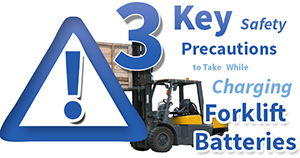We use cookies to make your experience better. To comply with the new e-Privacy directive, we need to ask for your consent to set the cookies. Learn more.
Three Key Safety Precautions to Take While Charging Forklift Batteries

The heart of many warehouses is the forklift battery charging and changing area, but this part of the warehouse is also filled with potential hazards that could bring operations to a halt.
The forklift battery is notorious for the number of hazards it presents to warehouse personnel. These 2,000-pound batteries contain corrosive chemicals, electrolyte, and heavy metals that make forklift battery maintenance highly dangerous if the right safety precautions aren't in place.
This is especially true when forklift batteries are being charged. During the charging process, anything from chemical spills to explosions can happen -- and that's why it's so important to prepare personnel for the worst-case scenario. In fact, the Occupational Health and Safety Administration, or OSHA, requires that all personnel working in the battery room be trained on all matters related to safety and forklift battery management.
To be sure that your warehouse's forklift battery handling area is a safe, productive place for all your personnel while they charge your forklift batteries, take these three safety precautions:
All personnel should wear personal protective equipment
Lead-acid and nickel-iron forklift batteries contain a number of highly corrosive chemicals. The battery changing and charging process can easily cause damaging accidental chemical exposure to the eyes and skin. Because of this, all personnel should wear goggles and chemical-resistant gloves, aprons, and face protection when working with forklift batteries.
Have a plan in place for electrolyte spills
Electrolyte is a main component of the forklift battery -- and this mixture of sulfuric acid and water is highly caustic. To protect against the possibility of electrolyte spray and spills during the charging process, all vent caps should be kept in place. Every battery changing area should be equipped with both spill kits and emergency wash stations. In addition, keep plenty of water on hand to flush away any electrolyte that comes in contact with skin.
Double-check battery and charger compatibility
Before placing a forklift battery on the battery charging station, be sure to double-check the charger's voltage and amperage and make sure it's compatible with the voltage and amperage of the battery itself. This information can be found on the battery data plate and on the charger data plate. This will help prevent overheating and lessen fire risk during the charging process as well as protect the lifespan of each forklift battery.
Have any other questions for us about battery room safety -- especially regarding chemical exposure and cleanup? Let us know by leaving a comment below this article.
